- Home
- Carl Sagan
Dragons of Eden Page 3
Dragons of Eden Read online
Page 3
ANSWER: A letter (0).
SECOND QUESTION: Is it in the first half (0) or the second half of the alphabet (1)?
ANSWER: In the first half (0).
THIRD QUESTION: Of the thirteen letters in the first half of the alphabet, is it in the first seven (0) or the second six (1)?
ANSWER: In the second six (1).
FOURTH QUESTION: In the second six (H, I, J, K, L, M), is it in the first half (0) or the second half (1)?
ANSWER: In the first half (0).
FIFTH QUESTION: Of these letters H, I, J, is it H (0) or is it one of I and J (1)?
ANSWER: It is one of I and J (1).
SIXTH QUESTION: Is it I (0) or J (1)?
ANSWER: It is J (1).
Specifying the letter J is therefore equivalent to the binary message, 001011. But it required not twenty questions but six, and it is in this sense that only six bits are required to specify a given letter. Therefore twenty billion bits are the equivalent of about three billion letters (2 × 1010/6 ≅ 3 × 109). If there are approximately six letters in an average word, the information content of a human chromosome corresponds to about five hundred million words (3 × 109/6 = 5 × 108). If there are about three hundred words on an ordinary page of printed type, this corresponds to about two million pages (5 × 108/3 × 102 ≅ 2 × 106). If a typical book contains five hundred such pages, the information content of a single human chromosome corresponds to some four thousand volumes (2 × 106/5 × 102 = 4 × 103). It is clear, then, that the sequence of rungs on our DNA ladders represents an enormous library of information. It is equally clear that so rich a library is required to specify as exquisitely constructed and intricately functioning an object as a human being. Simple organisms have less complexity and less to do, and therefore require a smaller amount of genetic information. The Viking landers that put down on Mars in 1976 each had preprogrammed instructions in their computers amounting to a few million bits. Thus Viking had slightly more “genetic information” than a bacterium, but significantly less than an alga.
The chart on this page also shows the minimum amount of genetic information in the DNA of various taxa. The amount shown for mammals is less than for human beings, because most mammals have less genetic information than human beings do. Within certain taxa—for example, the amphibians—the amount of genetic information varies wildly from species to species, and it is thought that much of this DNA may be redundant or functionless. This is the reason that the chart displays the minimum amount of DNA for a given taxon.
The evolution of information content in genes and brains during the history of life on Earth. The solid curve, which goes with the filled circles, represents the number of bits of information contained in the genes of various taxa, whose rough time of origin in the geological record is also shown. Because of variations in the amount of DNA per cell for certain taxa, only the minimum information content for a given taxon is shown, the data being taken from the work of Britten and Davidson (1969). The dashed curve, which goes with the open circles, is an approximate estimate of the evolution in the amount of information in the brains and nervous systems of these same organisms. The information in the brains of amphibians and still lower animals are off the left edge of the figure. The number of bits of information in the genetic material of viruses is shown, but it is not clear that viruses originated several billions of years ago. It is possible that viruses have evolved more recently, by loss of function, from bacteria or other more elaborate organisms. If the extrasomatic information of human beings were included (libraries, etc.), that point would be far off the lower right edge of the chart.
We see from the chart that there was a striking improvement in the information content of organisms on Earth some three billion years ago, and a slow increase in the amount of genetic information thereafter. We also see that if more than some tens of billions (several times 1010) of bits of information are necessary for human survival, extragenetic systems will have to provide them: the rate of development of genetic systems is so slow that no source of such additional biological information can be sought in the DNA.
The raw materials of evolution are mutations, inheritable changes in the particular nucleotide sequences that make up the hereditary instructions in the DNA molecule. Mutations are caused by radioactivity in the environment, by cosmic rays from space, or, as often happens, randomly—by spontaneous rearrangements of the nucleotides which statistically must occur every now and then. Chemical bonds spontaneously break. Mutations are also to some extent controlled by the organism itself. Organisms have the ability to repair certain classes of structural damage done to their DNA. There are, for example, molecules which patrol the DNA for damage; when a particularly egregious alteration in the DNA is discovered, it is snipped out by a kind of molecular scissors, and the DNA put right. But such repair is not and must not be perfectly efficient: mutations are required for evolution. A mutation in a DNA molecule within a chromosome of a skin cell in my index finger has no influence on heredity. Fingers are not involved, at least directly, in the propagation of the species. What counts are mutations in the gametes, the eggs and sperm cells, which are the agents of sexual reproduction.
Accidentally useful mutations provide the working material for biological evolution—as, for example, a mutation for melanin in certain moths, which changes their color from white to black. Such moths commonly rest on English birch trees, where their white coloration provides protective camouflage. Under these conditions, the melanin mutation is not an advantage—the dark moths are starkly visible and are eaten by birds; the mutation is selected against. But when the Industrial Revolution began to cover the birch bark with soot, the situation was reversed, and only moths with the melanin mutation survived. Then the mutation is selected for, and, in time, almost all the moths are dark, passing this inheritable change on to future generations. There are still occasional reverse mutations eliminating the melanin adaptation, which would be useful for the moths were English industrial pollution to be controlled. Note that in all this interaction between mutation and natural selection, no moth is making a conscious effort to adapt to a changed environment. The process is random and statistical.
Large organisms such as human beings average about one mutation per ten gametes—that is, there is a 10 percent chance that any given sperm or egg cell produced will have a new and inheritable change in the genetic instructions that determine the makeup of the next generation. These mutations occur at random and are almost uniformly harmful—it is rare that a precision machine is improved by a random change in the instructions for making it.
Most of these mutations are also recessive—they do not manifest themselves immediately. Nevertheless, there is already such a high mutation rate that, as several biologists have suggested, a larger complement of genetic DNA would bring about unacceptably high mutation rates: too much would go wrong too often if we had more genes.* If this is true, there must be a practical upper limit to the amount of genetic information that the DNA of larger organisms can accommodate. Thus large and complex organisms, by the mere fact of their existence, have to have substantial resources of extragenetic information. That information is contained, in all higher animals except Man, almost exclusively in the brain.
What is the information content of the brain? Let us consider two opposite and extreme poles of opinion on brain function. In one view, the brain, or at least its outer layers, the cerebral cortex, is equipotent: any part of it may substitute for any other part, and there is no localization of function. In the other view, the brain is completely hard-wired: specific cognitive functions are localized in particular places in the brain. Computer design suggests that the truth lies somewhere between these two extremes. On the one hand, any nonmystical view of brain function must connect physiology with anatomy; particular brain functions must be tied to particular neural patterns or other brain architecture. On the other hand, to assure accuracy and protect against accident we would expect natural selection to have evolved sub
stantial redundancy in brain function. This is also to be expected from the evolutionary path that it is most likely the brain followed.
The redundancy of memory storage was clearly demonstrated by Karl Lashley, a Harvard psychoneurologist, who surgically removed (extirpated) significant fractions of the cerebral cortex of rats without noticeably affecting their recollection of previously learned behavior on how to run mazes. From such experiments it is clear that the same memory must be localized in many different places in the brain, and we now know that some memories are tunneled between the left and right cerebral hemispheres by a conduit called the corpus callosum.
Lashley also reported no apparent change in the general behavior of a rat when significant fractions—say, 10 percent—of its brain were removed. But no one asked the rat its opinion. To investigate this question properly would require a detailed study of rat social, foraging, and predator-evasion behavior. There are many conceivable behavioral changes resulting from such extirpations that might not be immediately obvious to the casual scientist but that might be of considerable significance to the rat—such as the amount of post-extirpation interest an attractive rat of the opposite sex now elicits, or the degree of disinterest now evinced by the presence of a stalking cat.*
It is sometimes argued that cuts or lesions in significant parts of the cerebral cortex in humans—as by bilateral prefrontal lobotomy or by an accident—have little effect on behavior. But some sorts of human behavior are not very apparent from the outside, or even from the inside. There are human perceptions and activities that may occur only rarely, such as creativity. The association of ideas involved in acts—even small ones—of creative genius seems to imply substantial investments of brain resources. These creative acts indeed characterize our entire civilization and mankind as a species. Yet in many people they occur only rarely, and their absence may be missed by neither the brain-damaged subject nor the inquiring physician.
While substantial redundancy in brain function is inevitable, the strong equipotent hypothesis is almost certainly wrong, and most contemporary neurophysiologists have rejected it. On the other hand, a weaker equipotent hypothesis—holding, for example, that memory is a function of the cerebral cortex as a whole—is not so readily dismissable, although it is testable, as we shall see.
There is a popular contention that half or more of the brain is unused. From an evolutionary point of view this would be quite extraordinary: why should it have evolved if it had no function? But actually the statement is made on very little evidence. Again, it is deduced from the finding that many lesions of the brain, generally of the cerebral cortex, have no apparent effect on behavior. This view does not take into account (1) the possibility of redundant function; and (2) the fact that some human behavior is subtle. For example, lesions in the right hemisphere of the cerebral cortex may lead to impairments in thought and action, but in the nonverbal realm, which is, by definition, difficult for the patient or the physician to describe.
There is also considerable evidence for localization of brain function. Specific brain sites below the cerebral cortex have been found to be concerned with appetite, balance, thermal regulation, the circulation of the blood, precision movements and breathing. A classic study on higher brain function is the work of the Canadian neurosurgeon, Wilder Penfield, on the electrical stimulation of various parts of the cerebral cortex, generally in attempts to relieve symptoms of a disease such as psychomotor epilepsy. Patients reported a snatch of memory, a smell from the past, a sound or color trace—all elicited by a small electrical current at a particular site in the brain.
In a typical case, a patient might hear an orchestral composition in full detail when current flowed through Penfield’s electrode to the patient’s cortex, exposed after a craniotomy. If Penfield indicated to the patient—who typically is fully conscious during such procedures—that he was stimulating the cortex when he was not, invariably the patient would report no memory trace at that moment. But when, without notice, a current would flow through the electrode into the cortex, a memory trace would begin or continue. A patient might report a feeling tone, or a sense of familiarity, or a full retrieval of an experience of many years previous playing back in his mind, simultaneously but in no conflict with his awareness of being in an operating room conversing with a physician. While some patients described these flashbacks as “little dreams,” they contained none of the characteristic symbolism of dream material. These experiences have been reported almost exclusively by epileptics, and it is possible, although it has by no means been demonstrated, that non-epileptics are, under similar circumstances, subject to comparable perceptual reminiscences.
In one case of electrical stimulation of the occipital lobe, which is concerned with vision, the patient reported seeing a fluttering butterfly of such compelling reality that he stretched out his hand from the operating table to catch it. In an identical experiment performed on an ape, the animal peered intently, as if at an object before him, made a swift catching motion with his right hand, and then examined, in apparent bewilderment, his empty fist.
Painless electrical stimulation of at least some human cerebral cortices elicits cascades of memories of particular events. But removal of the brain tissue in contact with the electrode does not erase the memory. It is difficult to resist the conclusion that at least in humans memories are stored somewhere in the cerebral cortex, waiting for the brain to retrieve them by electrical impulses—which, of course, are ordinarily generated within the brain itself.
If memory is a function of the cerebral cortex as a whole—-a kind of dynamic reverberation or electrical standing wave pattern of the constituent parts, rather than stored statically in separate brain components—this would explain the survival of memory after significant brain damage. The evidence, however, points in the other direction: In experiments performed by the American neurophysiologist Ralph Gerard at the University of Michigan, hamsters were taught to run a simple maze and then chilled almost to the freezing point in a refrigerator, a kind of induced hibernation. The temperatures were so low that all detectable electrical activity in the animals’ brains ceased. If the dynamic view of memory were true, the experiment should have wiped out all memory of successful maze-running. Instead, after thawing, the hamsters remembered. Memory seems to be localized in specific sites in the brain, and the survival of memories after massive brain lesions must be the result of redundant storage of static memory traces in various locales.
Penfield, extending the findings of previous researchers, also uncovered a remarkable localization of function in the motor cortex. Certain parts of the outer layers of our brain are responsible for sending signals to or receiving signals from specific parts of the body. A version of Penfield’s maps of the sensory and motor cortices appear on this page. It reflects in an engaging way the relative importance of various parts of our body. The enormous amount of brain area committed to the fingers—particularly the thumb—and to the mouth and the organs of speech corresponds precisely to what in human physiology, through human behavior, has set us apart from most of the other animals. Our learning and our culture would never have developed without speech; our technology and our monuments would never have evolved without hands. In a way, the map of the motor cortex is an accurate portrait of our humanity.
But the evidence for localization of function is now much stronger even than this. In an elegant set of experiments, David Hubel of Harvard Medical School discovered the existence of networks of particular brain cells that respond selectively to lines perceived by the eye in different orientations. There are cells for horizontal, and cells for vertical, and cells for diagonal, each of which is stimulated only if lines of the appropriate orientation are perceived. At least some beginnings of abstract thought have thereby been traced to the cells of the brain.
The existence of specific brain areas dealing with particular cognitive, sensory or motor functions implies that there need not be any perfect correlation between brain mass and int
elligence; some parts of the brain are clearly more important than others. Among the most massive human brains on record are those of Oliver Cromwell, Ivan Turgenev and Lord Byron, all of whom were smart but no Albert Einsteins. Einstein’s brain, on the other hand, was not remarkably large. Anatole France, who was brighter than many, had a brain half the size of Byron’s. The human baby is born with an exceptionally high ratio of brain mass to body mass (about 12 percent); and the brain, particularly the cerebral cortex, continues to grow rapidly in the first three years of life—the period of most rapid learning. By age six, the mass of the brain is 90 percent of its adult value. The average mass of the brain of contemporary men is about 1,375 grams, almost three pounds. Since the density of the brain, like that of all body tissues, is about that of water (one gram per cubic centimeter), the volume of such a brain is 1,375 cubic centimeters, a little under a liter and a half. (One cubic centimeter is about the volume of an adult human navel.)
But the brain of a contemporary woman is about 150 cubic centimeters smaller. When cultural and child-rearing biases are taken into account, there is no clear evidence of overall differences in intelligence between the sexes. Therefore, brain mass differences of 150 grams in humans must be unimportant. Comparable differences in brain mass exist among adults of different human races (Orientals, on the average, have slightly larger brains than whites); since no differences in intelligence under similarly controlled conditions have been demonstrated there, the same conclusion follows. And the gap between the sizes of the brains of Lord Byron (2,200 grams) and Anatole France (1,100 grams) suggests that, in this range, differences of many hundreds of grams may be functionally unimportant.
On the other hand, adult human microcephalics, who are born with tiny brains, have vast losses in cognitive abilities; their typical brain masses are between 450 and 900 grams. A normal newborn child has a typical brain mass of 350 grams; a one-year-old, about 500 grams. It is clear that, as we consider smaller and smaller brain masses, there comes a point where the brain mass is so tiny that its function is severely impaired, compared to normal adult human brain function.

 Cosmos
Cosmos Murmurs of Earth
Murmurs of Earth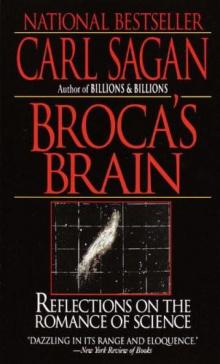 Broca's Brain
Broca's Brain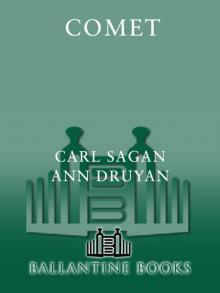 Comet
Comet Contact
Contact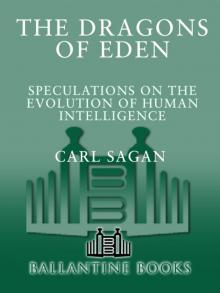 Dragons of Eden
Dragons of Eden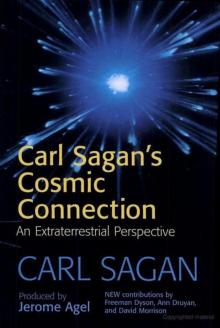 Cosmic Connection
Cosmic Connection Shadows of Forgotten Ancestors
Shadows of Forgotten Ancestors Billions & Billions
Billions & Billions Comet, Revised
Comet, Revised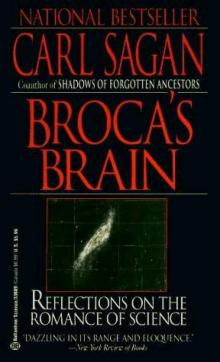 Broca's Brain: The Romance of Science
Broca's Brain: The Romance of Science The Varieties of Scientific Experience: A Personal View of the Search for God
The Varieties of Scientific Experience: A Personal View of the Search for God The Cosmic Connection
The Cosmic Connection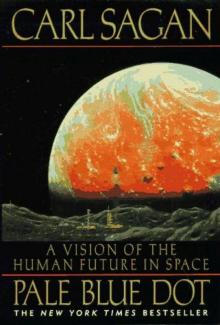 Pale Blue Dot: A Vision of the Human Future in Space
Pale Blue Dot: A Vision of the Human Future in Space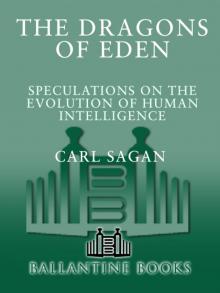 The Dragons of Eden
The Dragons of Eden